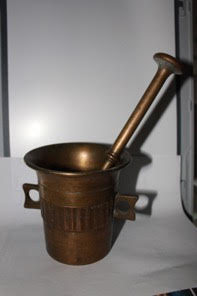
Story of the Mortar and Pestle
Czesław Blechinger (with the help of Anna Muller and Taylor Lenze)
During World War II, young Czeslaw Blechinger and his family were brought to Germany as forced laborers. They departed from Otynia Poland, a town south of Lwow, with only essentials and a decoratively wrought mortar and pestle.
The two brass pieces were intended to prove Blechinger's father’s technical craftsmanship competence, so they were not used on a daily basis. Blechinger explains that his father had “worked in the shop area, where railroad cars were maintained. A foundry was also in the shop, that’s where the mortar and pestle were made”.
When WWII ended, the mortar and pestle came with the Blechinger family to the displaced persons (DP) camp, called Bergen-Belsen. It was a former Nazi concentration camp where thousands of prisoners died including Margo and Anne Frank.
The family spent the winter 1945-1946 in this camp. Eight year old Blechinger saw the gas chamber and crematorium, a sight still vivid in his memory. The camp was extremely crowded, he and many other people slept in a very large room, on cots that were so close together that one could barely squeeze by.In the summer of 1946 the family was moved from one DP camp to another, eventually arriving at a DP camp in Saltzgitter. This camp housed mainly Polish people. Thanks to the relief program organized by the UN and US CARE packages, they survived.
Polish priests and teachers were also in the Salzgitter DP camp, making it possible to have Catholic Mass on Sundays and Polish classes including religion, reading, writing, arithmetic, geography and Boy Scout program.
"Geography was an interesting subject," Blechinger says. "At that time in DP camps there was much interest in geography because no one knew where one would live. Everyone wanted to go to America."
Travelling to America required an extensive vetting process, which included physical health, hearing, vision, literacy, good moral character, technical skill (demonstrated by the mortar and pestle) and a sponsor to provide a job.
Blechinger's family too took part in this dream and in 1949 immigrated to the US, the mortar and pestle again traveled with the family. "We lived on farms in Wisconsin for two years, then in Minnesota.
Post Script
Czesław Blechinger: "I thank the people of America for their generosity while we were still in the DP camps and for helping get away from the Communists who took our land and our home. The opportunity to use our skills and talents in the land of the free and the home of the brave allowed us to grow and become productive citizens of the United States of America."